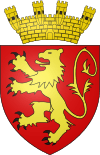Ġnien is-Sultan
- This article is about the former garden in Valletta. There is a district of the same name in Rabat, Malta.
| Ġnien is-Sultan | |
|---|---|
| Giardino della Marina | |
|
View of the garden circa 1880s | |
| Type | Garden |
| Location | Valletta, Malta |
| Coordinates | 35°53′40.2″N 14°30′46.7″E / 35.894500°N 14.512972°ECoordinates: 35°53′40.2″N 14°30′46.7″E / 35.894500°N 14.512972°E |
| Opened | 17th century |
| Closed | 19th–20th centuries |
| Founder | Giovanni Paolo Lascaris |
| Status | Destroyed |
Ġnien is-Sultan (Maltese for King's Garden), also known as the Giardino della Marina (Italian for Marina Garden), the Grand Master's Garden or Lascaris Garden, was a garden in Valletta, Malta. It was established in the 17th century by Giovanni Paolo Lascaris, and it included a summer residence for the Grand Master.
The summer residence and part of the garden was destroyed by the British military in the 19th century to make way for Lascaris Battery, a casemated artillery battery which was named after the Grand Master who had built the gardens. The remaining part of the garden was destroyed in the 20th century, and its site is now occupied by social housing blocks.
History
When Francesco Laparelli designed the fortifications of Valletta in 1566, he designed a two-tiered demi-bastion known as St. Peter and St. Paul Bastion on the eastern extremity of the city's land front, overlooking the Grand Harbour. The demi-bastion was too high to offer adequate defence, so in the early 17th century the rocky shore below it was reshaped into a faussebraye (or tenaille) with a rock-hewn ditch stretching from the bastion to the Del Monte Gate. Construction was entrusted to the local contractor Maestro Xara. This rampart became known as Lascaris Bastion, after Grand Master Giovanni Paolo Lascaris, who had commissioned its construction.[1]
_b_101.jpg)
Soon after the rampart was completed, Grand Master Lascaris requisitioned the site and he built a summer residence with a garden there. The garden contained a belvedere and several fountains which were supplied by water from the Wignacourt Aqueduct.[2][3] The garden became the focal point of the Valletta Marina, which also included the Church of Our Lady of Liesse, Neptune's Fountain and the Del Monte Gate. The area became one of the most picturesque parts of Valletta, and it was depicted in several paintings between the 17th and 19th centuries.[1]
The baroque garden, which included a number of evergreen fruit trees mainly consisting of lemon trees, the triumphal arch (the gate) and two eleborate baroque fountains were designed by architect Buonamici.[4]
By 1839, the Grand Master's summer residence housed the superintendent of the quarantine department and of the port of Valletta.[5]
_01_ies.jpg)
The summer residence and part of the garden was destroyed in the mid-19th century to make way for the Lascaris Battery, a casemated artillery battery which was built by the British military in order to defend the Grand Harbour, in particular the newly built drydock.[1] Eventually, case bottege began to be built on the remaining parts of the garden, and the site was fully built up as social housing blocks in the 1980s.[3]
Remains
Very few remains from the garden still survive. The lower part of a staircase which led to the Grand Master's summer residence can still be seen at the base of Lascaris Battery.[7] The garden's belvedere has also survived. A fountain from the garden was discovered in 1956 during excavations in the ruins, and it was relocated to Argotti Gardens in Floriana, where it remains today. The fountain has a concave basin with bays divided by Tuscan pillars.[3]
The belvedere and fountain are scheduled as Grade 1 national monuments by the Malta Environment and Planning Authority.[3]
References
- 1 2 3 Spiteri, Stephen C. (6 June 2016). "Gnien is-Sultan". MilitaryArchitecture.com. Retrieved 3 July 2016.
- ↑ "The Water Supply of the Maltese Islands" (PDF). Archivum Melitense. Malta Historical and Scientific Society. VII (1): 8. 1922. Archived from the original (PDF) on 4 March 2016.
- 1 2 3 4 "One World – Protecting the most significant buildings, monuments and features of Valletta (99)". Times of Malta. 19 March 2009. Archived from the original on 3 July 2016.
- ↑ UOM. pp. 12-13.
- ↑ MacGill, Thomas (1839). A hand book, or guide, for strangers visiting Malta. Malta: Luigi Tonna. p. 68.
- ↑ Guillaumier, Alfie (2005). Bliet u Rħula Maltin. Klabb Kotba Maltin. p. 943. ISBN 99932-39-40-2.
- ↑ Scerri, John (4 March 2012). "Set 8 pitturi / paintings – 1. Gnien is-Sultan – Grandmaster's Garden". malta-canada.blogspot. Archived from the original on 3 July 2016.
![]() Media related to Ġnien is-Sultan at Wikimedia Commons
Media related to Ġnien is-Sultan at Wikimedia Commons


